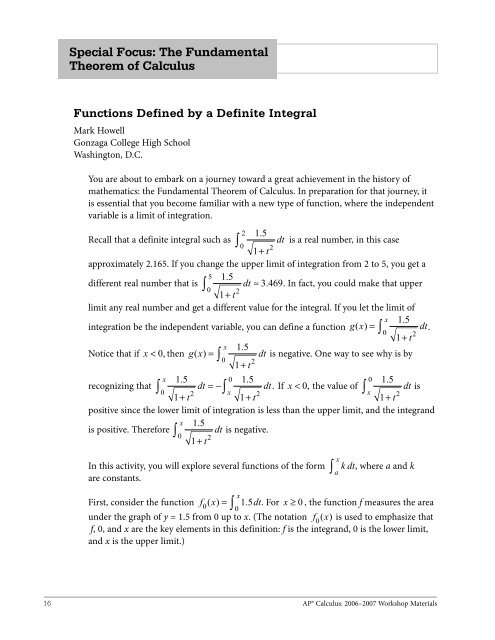AP Calculus
Calculus_SF_Theorem
Calculus_SF_Theorem
Create successful ePaper yourself
Turn your PDF publications into a flip-book with our unique Google optimized e-Paper software.
Special Focus: The Fundamental<br />
Theorem of <strong>Calculus</strong><br />
Functions Defined by a Definite Integral<br />
Mark Howell<br />
Gonzaga College High School<br />
Washington, D.C.<br />
You are about to embark on a journey toward a great achievement in the history of<br />
mathematics: the Fundamental Theorem of <strong>Calculus</strong>. In preparation for that journey, it<br />
is essential that you become familiar with a new type of function, where the independent<br />
variable is a limit of integration.<br />
2 1.<br />
5<br />
Recall that a definite integral such as ∫ dt is a real number, in this case<br />
0 2<br />
1+<br />
t<br />
approximately 2.165. If you change the upper limit of integration from 2 to 5, you get a<br />
5 1.<br />
5<br />
different real number that is ∫ dt ≈ 3.<br />
469. In fact, you could make that upper<br />
0 2<br />
1+<br />
t<br />
limit any real number and get a different value for the integral. If you let the limit of<br />
x 1.<br />
5<br />
integration be the independent variable, you can define a function g( x)<br />
= ∫ dt.<br />
0 2<br />
1+<br />
t<br />
x 1.<br />
5<br />
Notice that if x < 0, then g( x)<br />
= ∫ dt is negative. One way to see why is by<br />
0 2<br />
1+<br />
t<br />
x 1. 5<br />
0 1.<br />
5<br />
0 1.<br />
5<br />
recognizing that ∫ dt = −<br />
0 ∫ dt. If x < 0, the value of<br />
2 x<br />
∫ dt is<br />
2<br />
x 2<br />
1+<br />
t<br />
1+<br />
t<br />
1+<br />
t<br />
positive since the lower limit of integration is less than the upper limit, and the integrand<br />
x 1.<br />
5<br />
is positive. Therefore ∫ dt is negative.<br />
0 2<br />
1+<br />
t<br />
In this activity, you will explore several functions of the form<br />
are constants.<br />
∫<br />
x<br />
a<br />
k dt, where a and k<br />
x<br />
First, consider the function f0 ( x ) = ∫ 1.<br />
5 dt. For x ≥ 0 , the function f measures the area<br />
0<br />
under the graph of y = 1.5 from 0 up to x. (The notation f0 ( x) is used to emphasize that<br />
f, 0, and x are the key elements in this definition: f is the integrand, 0 is the lower limit,<br />
and x is the upper limit.)<br />
16<br />
<strong>AP</strong>® <strong>Calculus</strong>: 2006–2007 Workshop Materials


